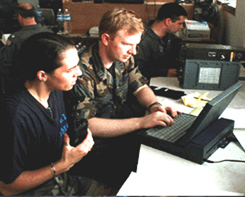
To comply with a Belgium Royal Decree, the 80th Area Support Group (ASG) requested an ergonomic assessment of video display terminal (VDT) workstations within their Area of Responsibility in Belgium. The Belgium Royal Decree mandates that there be an annual evaluation of all VDT workstations used by Local Nationals for more than 4 hours each day. The 80th ASG expanded the requirement to encompass all VDT workstations within their Area of Responsibility regardless of nationality of the operator.
An ergonomics team from the U.S. Army Center for Health Promotion and Preventive Medicine evaluated 340 VDT workstations during the period 9-27 February 1997.
The desks and chairs in use at the time of the assessment were purchased before the advent of desktop computers and, therefore, were not designed specifically for use with VDTs. Risk factors, such as awkward postures, repetitive motions, and mechanical stresses (sharp corners or edges on desks) were evident at most of the workstations. These risk factors can lead to cumulative trauma disorders, such as carpal tunnel syndrome.
The evaluation team identified specific ergonomic hazards attributable to the design of the workstations. Below are the team’s primary findings and recommended solutions.
Fact sheets
An effective ergonomics program fits the workplace to the worker.
You should know about work-related musculoskeletal disorders
You should know about carpal tunnel syndrome.
Proper use of hand tools can make your work safer and easier.
Proper use of powered hand tools can make your work safer and easier.
You can identify the characteristics of a hazardous materials-handling task.
You should know how to safely perform lifting and lowering tasks.
You should know how to safely perform pushing and pulling tasks.
You should know how to safely carry heavy loads.
You can evaluate ergonomic products to see if they truly meet your needs.
You can make your computer workstation “fit” your needs.
You should know what you can do to solve your computer-related discomfort.
Your computer workstation should be in a comfortable work area.
Your computer workstation should include a desk that’s right for you.
Your computer workstation should include a chair that’s right for you.
Your computer workstation may need a footrest.
Your computer workstation should include a monitor that’s easy to view.
Your computer workstation should include the right keyboard for you.
Your computer workstation should include the right input device for you.
Your computer workstation may need a document holder.
Your computer workstation should receive appropriate lighting and guard against glare.
You should know how to prevent injuries while using your laptop.
You can troubleshoot pain and discomfort in your office.
